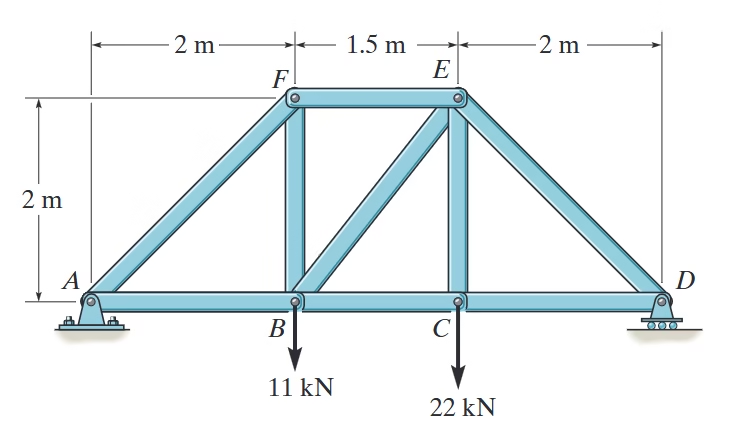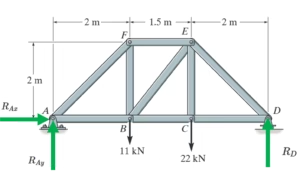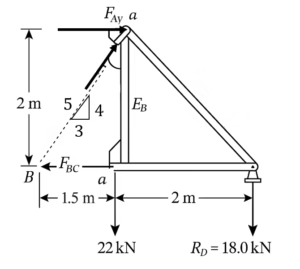$6–41.$ Determine the force developed in members $FE$, $EB$, and $BC$ of the truss and state if these members are in tension or compression

$ \text{Step by Step Solution} $
$ \text{Step 1: Given Data} $
We are tasked with determining the forces in members $FE$, $EB$, and $BC$ of the truss and identifying whether these forces are in tension (T) or compression (C).
\begin{array}{c}
\text{Forces:} \\
F_1 = 11\,\text{kN} \\
F_2 = 22\,\text{kN}
\end{array}
$ \text{Step 2: Free Body Diagram} $
The free body diagram of the truss is shown below, illustrating all applied forces and support reactions.

$ \text{Step 3: Horizontal Reaction at A} $
The horizontal reaction at support A is determined by equilibrium of forces in the x-direction:
\begin{array}{c}
R_{Ax} = 0
\end{array}
$ \text{Step 4: Vertical Reactions} $
The vertical reactions are related by the equilibrium condition:
\begin{array}{c}
R_{Ay} + R_D = F_1 + F_2 \quad \text{(1)}
\end{array}
$ \text{Step 5: Moment About Point A} $
Taking moments about point A to solve for $R_D$:
\begin{array}{c}
R_D \times (5.5\,\text{m}) = F_1 \times (2\,\text{m}) + F_2 \times (3.5\,\text{m}) \\
R_D = \frac{F_1 \times 2 + F_2 \times 3.5}{5.5}
\end{array}
$ \text{Step 6: Calculate $R_D$} $
Substituting the given values:
\begin{array}{c}
R_D = \frac{11 \times 2 + 22 \times 3.5}{5.5} \\
= \frac{22 + 77}{5.5} \\
= 18.0\,\text{kN}
\end{array}
$ \text{Step 7: Calculate $R_{Ay}$} $
Using equation (1) to find $R_{Ay}$:
\begin{array}{c}
R_{Ay} = F_1 + F_2 – R_D \\
= 11 + 22 – 18 \\
= 15\,\text{kN}
\end{array}
$ \text{Step 8: Method of Sections} $
We apply the method of sections by cutting through members $FE$, $EB$, and $BC$.
$ \text{Step 9: Force in Member BC} $
Taking moments about point E to find $F_{BC}$:
\begin{array}{c}
F_{BC} \times (2\,\text{m}) = R_D \times (2\,\text{m}) \\
F_{BC} = R_D \\
= 18.0\,\text{kN (T)}
\end{array}
The positive value confirms member BC is in tension.
$ \text{Step 10: Force in Member FE} $
Taking moments about point B to find $F_{FE}$:
\begin{array}{c}
F_{FE} \times (2\,\text{m}) = R_D \times (3.5\,\text{m}) – F_2 \times (1.5\,\text{m}) \\
F_{FE} = \frac{18 \times 3.5 – 22 \times 1.5}{2} \\
= \frac{63 – 33}{2} \\
= 15.0\,\text{kN (C)}
\end{array}
The positive value confirms member FE is in compression.
$ \text{Step 11: Force in Member EB} $
Summing forces in the y-direction to find $F_{EB}$:
\begin{array}{c}
F_{EB} \times \left(\frac{4}{5}\right) + R_D – F_2 = 0 \\
F_{EB} = (F_2 – R_D) \times \left(\frac{5}{4}\right) \\
= (22 – 18) \times 1.25 \\
= 5.0\,\text{kN (C)}
\end{array}
The positive value confirms member EB is in compression.
$ \text{Conclusion} $
\begin{array}{ll}
\text{Member FE:} & 15.0\,\text{kN in compression (C)} \\
\text{Member EB:} & 5.0\,\text{kN in compression (C)} \\
\text{Member BC:} & 18.0\,\text{kN in tension (T)}
\end{array}

Leave a reply